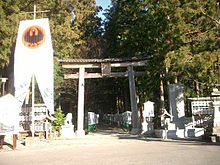Yatagarasu

Yatagarasu or Yatakarasu or Yata no karasu ( Japanese八 咫 烏; Karl Florenz translates as “eight-hand crow” in the sense of “multi-handed (multi-clawed) crow”, Motoori Norinaga interprets as “eight-headed crow”) is a kami in the mythology of Shinto . It is shaped like a three-legged crow .
origin
In the myths, Yatagarasu appears as the envoy of the heavenly Kami, who served the (also mythical) Jimmu - tennō during his conquest of Japan during the campaign in the east as a flying guide to Uda (in the province of Yamashiro ; the tradition of the Kumano shrines according to up to present location of Kumano Nachi-Taisha ) helps. In Kojiki sends him Takagi no kami , the Jimmu wants to protect them from the earthly Kami inland. In Nihonshoki it is Amaterasu who sends the crow and Jimmu, in his sleep, after his army cannot advance further inland because of the steep and impassable mountains, tells about it in a dream. In both works, Yatagarasu later acts as an envoy for Jimmu to bring messages to his enemies.
In the Kogoshūi , Yatagarasu is identified as the ancestor of the Kamo no Agata-nushi . The Shinsen Shōjiroku even reports that "the ancestor of this race was the Kamo Take Tsunomi no Mikoto , descended from Kami-musubi no Mikoto, and that he assumed the shape of the great crow in order to perform the service mentioned." The Kamo no Agata- nushi (also Kazunu no Agata-nushi or Kadono no Agata-nushi in Nihonshoki) were the first family of high priests at the Kamigamo shrine .
Because of his skills as a shapeshifter, he plays an important role in some esoteric Shinto cults.

In research it is mostly assumed that Yatagarasu developed from similar mythical creatures from the Sino-Korean cultural area. This is supported, among other things, by the fact that the Nihonshoki reports that in 650, during the reign of the Kōtoku -tennō, the emissaries from China brought a dead three-legged crow with them.
Shrines
According to the Yamashiro Fudoki , Kamo Take Tsunomi no Mikoto was worshiped under the name of Kamo Take Tsunumi no Mikoto in the western honors of the Kamo-mi-oya Shrine in Yamashiro Province . He is currently worshiped under the name Yatagarasu in his Tobe-sha (a massha ).
The Shoku Nihongi reports of a Yatanokarasu shrine in the Uda district of the Yamato province , which is said to have been inaugurated in the ninth month of the year 705, which corresponds to a corresponding place in the directory of gods ( Jinmyōchō ) of the Engishiki .
Mostly Yatagarasu is venerated under the name (Kamo no) Take Tsunumi no Mikoto, among others in Yatagarasu-jinja , a side shrine of Kumano Hongū-Taisha , in Kakehiko-jinja (a massha of Kumano Nachi-Taisha ), in three other Yatagarasu -jinja in the area of the former province of Yamato , in the central shrine of Mitsui-no-yashiro (a sessha of the Shimogamo shrine ) and with Tama-yori-hime in the Mikage-jinja (also a sessha of the Shimogamo shrine).
In Kashihara-jingū , Yatagarasu is revered as Shinshi (animals that function as personal servants of Kami) of Jimmu-tennō.
Festivals
Some very important festivals are held in the Kumano shrines in honor of Yatagarasu:
- On the morning of January 1st, water from the nearby waterfall is brought to the Kumano Nachi-Taisha by a priest wearing a black cap called Yatagarasu-bō , which depicts a stylized crow. An esoteric and very secret Norito is sung and amulets ( shimpu ) are made for safe births or to ward off insect damage to the rice harvest.
- On the evening of January 7th (according to the lunar calendar ) the Yatagarasu shinji or Hōin shinji takes place in the Haiden of the Kumano Hongū-Taisha . Various seals with the face of Yatagarasu ( go-ō-no-shimpu or gyu-o ) are printed on paper and distributed to believers across the country. In popular belief it is said that whoever burns such a seal and swallows the ashes of it must tell the truth if he opens his mouth again, otherwise he is threatened with spitting blood or even dying.
Other cultural significance
Yatagarasu can be found since June 3, 1931 ( Shōwa 6) on the emblems of the Japan Football Association and the Japanese national football team .
In addition, on May 4, 2004, an asteroid from the asteroid belt was named after him ( (9106) Yatagarasu ).
Individual evidence
- ↑ Karl Florenz: The historical sources of the Shinto religion . Vandenhoeck & Ruprecht, Göttingen and Leipzig 1919, p. 430f.
- ↑ FAQ of the JFA
Web links
- Nishioka Kazuhiko: "Yatakarasu" . In: Encyclopedia of Shinto. Kokugaku-in , May 13, 2005 (English)
